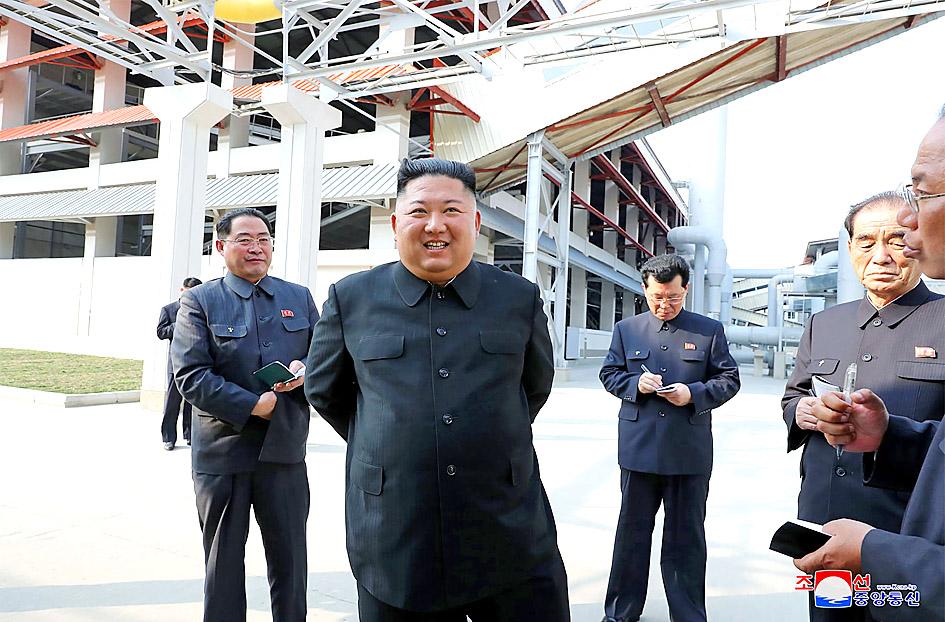When North Korea broke a three-week silence on leader Kim Jong-un’s public activity yesterday, it offered no clue as to where he had been during a period of intense global speculation about his health and whereabouts, or why he was hidden from the public for so long.
Instead, state media simply showed him surrounded by aides and appearing confident at a gleaming fertilizer factory that is believed by outside experts to be part of a secret nuclear weapons program.
While much remains a mystery about Kim’s condition, the abrupt re-emergence of the relaxed and smiling leader was an obvious choreography of key messages from the secretive government: Kim is the supreme leader in full control of a drive to improve the impoverished country’s food security and economy, amid tough international sanctions and the threat of the COVID-19 pandemic.

Photo: AFP
The official Rodong Sinmun yesterday devoted three of its six pages to touting Kim’s leadership, crediting him for what it called “prosperity and self-reliance.”
Reuters could not verify the accuracy of official accounts or the authenticity of pictures from the event.
The sprawling complex is the result of Kim’s vision to build a modern factory that would support agricultural production and make progress in automating its chemical industry, former North Korean premier Pak Pong-ju said at the ribbon-cutting ceremony where Kim reappeared.
Kim’s appearance at the Sunchon fertilizer plant, which official media said occurred on Friday, was an example of “field guidance” — a key part of Kim’s public persona, where he presides over a major industrial or social project event, or at military drills involving strategic weapons, such as ballistic missiles or tactical warfare.
His second public visit this year to the site 50km north of the capital, Pyongyang, included a sizeable audience of officials from the army, the ruling Workers’ Party of Korea and the local community. Many wore masks in an apparent precaution against the coronavirus.
“Agricultural production is a top priority, which has a direct impact on the lives of the people,” said Koh Yu-hwan, president of the Korea Institute for National Unification, a South Korean government think-tank.
Kim’s sudden return was “a strategy to be in the center of world news without resorting to nuclear or missile tests,” Koh said.
The phosphate fertilizer factory in Sunchon, under construction since June 2017, has received much attention from North Korea’s leaders.
International observers have said that the plant is part of the North’s clandestine pursuit of uranium extraction for use in nuclear weapons, as the mineral can be a byproduct of making phosphate fertilizer.
There is strong evidence the factory is involved in uranium extraction, said a report this month by the California-based James Martin Center for Nonproliferation Studies.

SECURITY: As China is ‘reshaping’ Hong Kong’s population, Taiwan must raise the eligibility threshold for applications from Hong Kongers, Chiu Chui-cheng said When Hong Kong and Macau citizens apply for residency in Taiwan, it would be under a new category that includes a “national security observation period,” Mainland Affairs Council (MAC) Minister Chiu Chui-cheng (邱垂正) said yesterday. President William Lai (賴清德) on March 13 announced 17 strategies to counter China’s aggression toward Taiwan, including incorporating national security considerations into the review process for residency applications from Hong Kong and Macau citizens. The situation in Hong Kong is constantly changing, Chiu said to media yesterday on the sidelines of the Taipei Technology Run hosted by the Taipei Neihu Technology Park Development Association. With

CARROT AND STICK: While unrelenting in its military threats, China attracted nearly 40,000 Taiwanese to over 400 business events last year Nearly 40,000 Taiwanese last year joined industry events in China, such as conferences and trade fairs, supported by the Chinese government, a study showed yesterday, as Beijing ramps up a charm offensive toward Taipei alongside military pressure. China has long taken a carrot-and-stick approach to Taiwan, threatening it with the prospect of military action while reaching out to those it believes are amenable to Beijing’s point of view. Taiwanese security officials are wary of what they see as Beijing’s influence campaigns to sway public opinion after Taipei and Beijing gradually resumed travel links halted by the COVID-19 pandemic, but the scale of

A US Marine Corps regiment equipped with Naval Strike Missiles (NSM) is set to participate in the upcoming Balikatan 25 exercise in the Luzon Strait, marking the system’s first-ever deployment in the Philippines. US and Philippine officials have separately confirmed that the Navy Marine Expeditionary Ship Interdiction System (NMESIS) — the mobile launch platform for the Naval Strike Missile — would take part in the joint exercise. The missiles are being deployed to “a strategic first island chain chokepoint” in the waters between Taiwan proper and the Philippines, US-based Naval News reported. “The Luzon Strait and Bashi Channel represent a critical access

Pope Francis is be laid to rest on Saturday after lying in state for three days in St Peter’s Basilica, where the faithful are expected to flock to pay their respects to history’s first Latin American pontiff. The cardinals met yesterday in the Vatican’s synod hall to chart the next steps before a conclave begins to choose Francis’ successor, as condolences poured in from around the world. According to current norms, the conclave must begin between May 5 and 10. The cardinals set the funeral for Saturday at 10am in St Peter’s Square, to be celebrated by the dean of the College